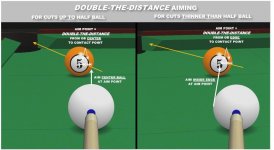I've been playing for a little less than a year and gone through a number of aiming theories. All of them have been from youtube videos, reading, etc; no private lessons yet. I started with ghost ball, pivot systems and a few others.
Last week I made up my own I'll call the Equal Overlap system. I'm sure it's not original and other folks have used something similar if not exactly the same.
Basically I begin by determining the contact point by standing on a line-of-sight from the OB to the pocket. While keeping my eye on that point, I walk to the sight line between the CB and the OB (roughly the shot line). Since the balls are perfect spheres their intersection (contact point) will occur exactly in the middle of the overlap between the CB and the OB. So I determine where the contact point is between the center and edge of the OB, and then aim the CB at the OB with an equal overlap. I think of the CB as being the mirror image of the OB; it's just on the "hitting side" rather than the "being hit" side.
I don't know if I've explained it well; my apologies if I haven't.
Anyway, I'd like to explore it further and thought you guys might know of similar methods and point me in the right direction.
Thanks.
Last week I made up my own I'll call the Equal Overlap system. I'm sure it's not original and other folks have used something similar if not exactly the same.
Basically I begin by determining the contact point by standing on a line-of-sight from the OB to the pocket. While keeping my eye on that point, I walk to the sight line between the CB and the OB (roughly the shot line). Since the balls are perfect spheres their intersection (contact point) will occur exactly in the middle of the overlap between the CB and the OB. So I determine where the contact point is between the center and edge of the OB, and then aim the CB at the OB with an equal overlap. I think of the CB as being the mirror image of the OB; it's just on the "hitting side" rather than the "being hit" side.
I don't know if I've explained it well; my apologies if I haven't.
Anyway, I'd like to explore it further and thought you guys might know of similar methods and point me in the right direction.
Thanks.

